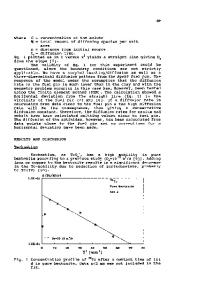Corrosion of Iron and Migration of Corrosion Products in Compacted Bentonite
- PDF / 377,070 Bytes
- 8 Pages / 414.72 x 648 pts Page_size
- 67 Downloads / 304 Views
CORROSION OF IRON AND MIGRATION OF CORROSION PRODUCTS IN COMPACrED BENTONITE T. Kozaki*, Y. Imamura*, J. Takada**, S. Sato* and H. Ohashi* *Hokkaido Univ., Department of Nuclear Engineering, Sapporo 060, Japan
"**Research Reactor
Institute, Kyoto Univ., Kumatori-cho, Sennan-gun, Osaka, 590-04,
Japan
ABSTRACT For safety assessment of the geological disposal of the high level radioactive waste, it is necessary to study corrosion of the overpack materials and migration of the corrosion products in the compacted bentonite. In the present study, average corrosion rates of iron foil and apparent diffusion coefficients of the corrosion products were determined using a neutron- activated iron foil. The average corrosion rates were on the order of 10 6m/y, while apparent diffusion coefficients were in the range from 10.12 to 2 10 14m /s. No tendency to decrease in the corrosion rates with increasing corrosion time
was observed. This suggests that the iron foil corrodes under reducing condition. Asymmetric concentration profiles of iron corrosion products were obtained in some experiments. It can be considered that either cathodic or anodic reaction would dominantly occur on one side of the iron foil surfaces and that each reaction would change the pH in pore water of bentonite specimens adjacent to the iron foil surfaces.
INTRODUCTION For safe disposal of the high level radioactive waste, a geological disposal method has been investigated in Japan[I] as well as other countries. In the method, a compacted bentonite- carbon steel system plays an important role as an engineered barrier in containment of radioactive materials. For safety assessment of the geological disposal, it is necessary to study corrosion behavior of the overpack materials in the compacted bentonite, which is expected to be affected by migration behavior of iron corrosion products, as well as by other parameters such as gas permeability and chemical composition of groundwater. Several reports concerning corrosion rates of carbon steel are available. Simpson et al. have reported the corrosion rates for cast iron specimens under various conditions by measuring the weight loss of the specimens and the amount of hydrogen generated from the cathodic reaction[2]. At high temperatures of 150 and 250°C, corrosion rates of low- carbon steel have been also reported by Anantatmula et Mat. Res. Soc. Symp. Proc. Vol. 353 01995 Materials Research Society
330
al.[3]. On the other hand, from the viewpoint of migration of the corrosion products, Madsen and Kahr have determined the apparent diffusion coefficients of FeCI2 in the Idemitsu et al. have also reported the
compacted bentonite by chemical analysis[4].
apparent diffusion coefficients of iron in the compacted bentonite with and without carbon steel[5]. In this study, a neutron- activated iron foil was used as simulated overpack material to study both corrosion of iron and migration of corrosion products in the compacted bentonite. Average corrosion rates of the iron foil and apparent diffusion coefficient
Data Loading...











